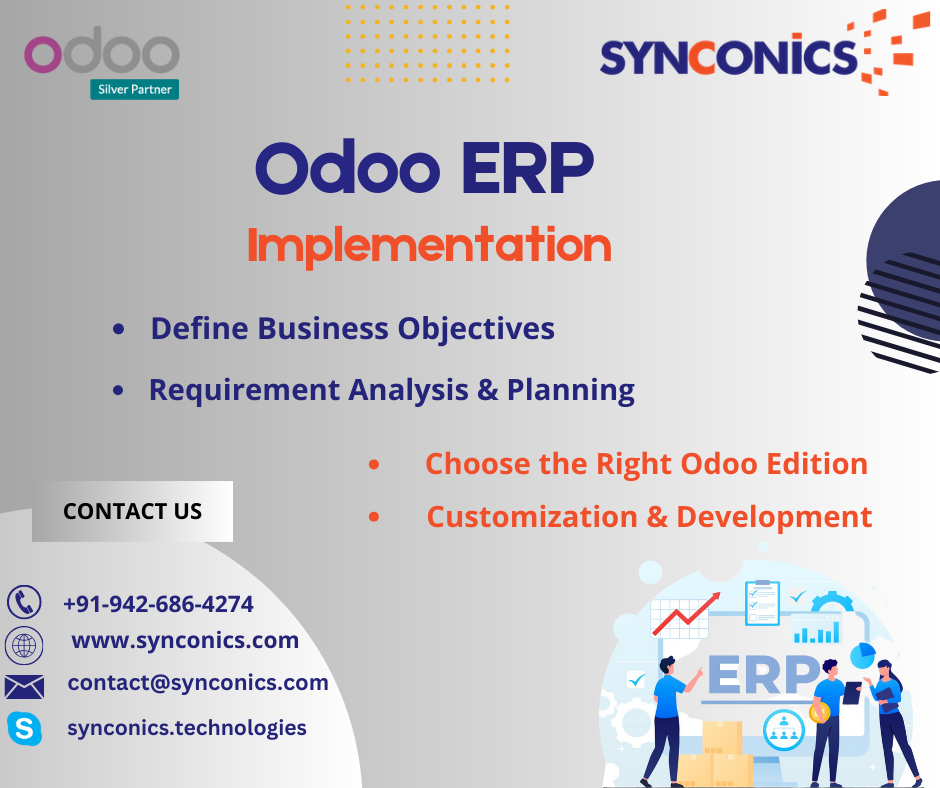
Odoo, an all-in-one open-source ERP, revolutionizes business operations by integrating multiple processes into a single, user-friendly platform. However, successful Odoo implementation requires meticulous planning, customization, and a structured approach to ensure it aligns with business objectives.
Why Odoo Implementation Matters
Implementing Odoo is not just about adopting a new software solution—it’s about transforming business workflows, automating tasks, and enhancing efficiency. The right implementation approach ensures:
-
Seamless integration of business operations.
-
Reduction of manual errors and redundancies.
-
Enhanced data-driven decision-making.
-
Scalability to accommodate future business growth.
Despite its numerous benefits, implementation challenges can arise, making expert guidance essential.
Key Stages of Odoo Implementation
1. Business Process Analysis & Requirement Gathering
A deep understanding of the company’s workflows, pain points, and expectations is critical. The goal is to:
-
Identify gaps in the existing system.
-
Define key business objectives.
-
Select the most relevant Odoo modules.
-
Map out current and future workflow needs.
2. Project Planning & Scope Definition
A structured Odoo implementation plan is essential to avoid delays and budget overruns. This includes:
-
Establishing project timelines and milestones.
-
Allocating resources and defining team roles.
-
Determining the customization and integration scope.
-
Setting key performance indicators (KPIs) for success.
3. System Configuration & Customization
Odoo’s flexibility allows businesses to tailor the system to their needs. This phase covers:
-
Module selection and setup.
-
Custom workflow automation.
-
Integration with third-party tools like payment gateways, shipping providers, or legacy systems.
Customization ensures that Odoo aligns perfectly with business-specific requirements.
4. Data Migration & System Integration
Migrating data from legacy systems is a critical step in ensuring a smooth transition. The process involves:
-
Extracting, cleaning, and structuring data.
-
Mapping old data fields to Odoo’s structure.
-
Ensuring data accuracy through validation.
-
Testing integrations with existing applications.
5. Testing & Quality Assurance
Before deployment, rigorous testing ensures the system functions seamlessly. This phase includes:
-
Functional Testing – Ensuring all modules work as expected.
-
Performance Testing – Checking system responsiveness and scalability.
-
User Acceptance Testing (UAT) – Allowing key users to test the system in real-world scenarios.
Testing minimizes risks and prevents unexpected failures after deployment.
6. Training & Change Management
User adoption is crucial to a successful implementation. Training programs should:
-
Educate employees on Odoo’s features and workflows.
-
Provide hands-on sessions with real-time scenarios.
-
Address resistance to change with clear communication.
A well-trained workforce ensures a smoother transition and maximized system utilization.
7. Deployment & Go-Live
Once testing and training are complete, the system goes live. Key steps include:
-
Running the system in parallel with the old one (if needed).
-
Monitoring real-time data processing.
-
Addressing any last-minute adjustments.
-
Ensuring continuous technical support.
8. Post-Implementation Support & Optimization
Odoo implementation doesn’t end with deployment; continuous monitoring and support ensure long-term success. This includes:
-
Regular updates to keep the system optimized.
-
Bug fixes and troubleshooting to maintain smooth operations.
-
System scaling as business needs grow.
-
Employee feedback analysis for further refinements.
Continuous improvement ensures that the ERP evolves with the business.
Common Challenges in Odoo Implementation & How to Overcome Them
1. Resistance to Change
Employees may hesitate to adopt a new system due to unfamiliarity. Solution: Offer extensive training, highlight Odoo’s benefits, and provide ongoing support.
2. Data Migration Issues
Data inconsistencies or loss during migration can impact operations. Solution: Conduct a thorough audit, clean data before migration, and test migration processes in a sandbox environment.
3. Customization Delays
Over-customization can slow down implementation. Solution: Prioritize essential customizations and implement additional changes gradually.
4. Integration Complexities
Integrating Odoo with existing third-party tools can be challenging. Solution: Work with experienced Odoo consultants who specialize in API integrations.
5. Lack of Proper Support
Post-implementation issues may arise, requiring technical expertise. Solution: Ensure continuous technical support and system monitoring.
Best Practices for a Successful Odoo Implementation
-
Adopt a phased approach rather than implementing all modules at once.
-
Define clear objectives and KPIs to measure success.
-
Involve key stakeholders from different departments.
-
Choose experienced Odoo consultants for customization and deployment.
-
Invest in training to ensure maximum user adoption.
Conclusion
A successful Odoo implementation is more than just deploying an ERP system—it’s a strategic transformation that streamlines business processes, enhances efficiency, and drives growth. By following a structured approach, businesses can minimize risks, overcome implementation challenges, and maximize Odoo’s potential. From requirement analysis to post-deployment optimization, each phase plays a crucial role in ensuring a seamless transition. With the right planning, expert guidance, and ongoing support, Odoo becomes a powerful tool that evolves with the business, paving the way for long-term success and scalability.
This post was created with our nice and easy submission form. Create your post!





